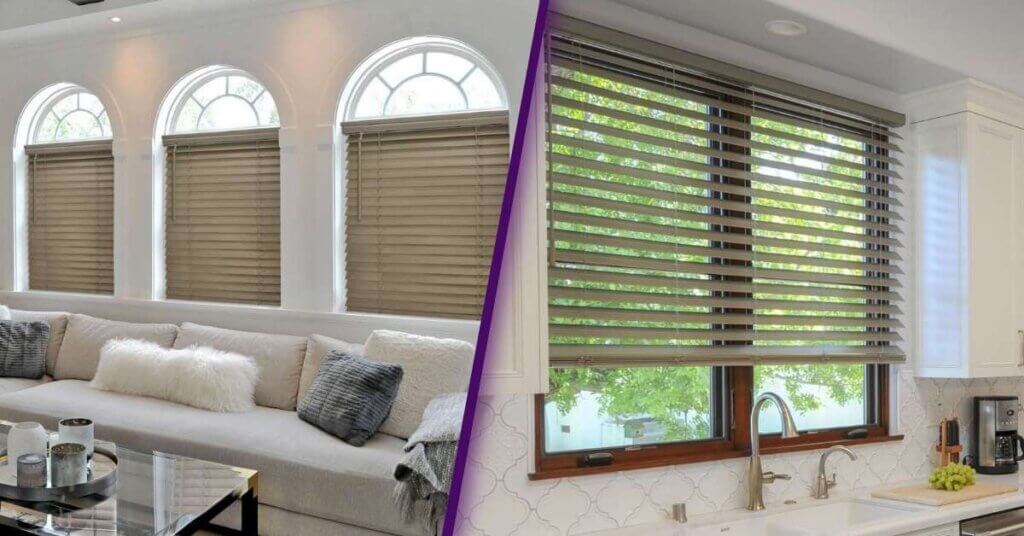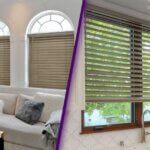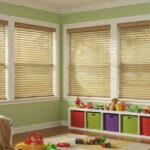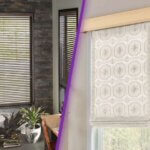When choosing between wood blinds vs. faux wood blinds, homeowners often start with appearance. Both look elegant and timeless, but the differences go far deeper than what meets the eye. From durability and insulation to cost and maintenance, understanding the key distinctions can help you make an informed decision that fits your lifestyle and environment. This guide breaks down every aspect—materials, performance, pros, and cons—to help you choose the best blinds for your home.
Now, let’s look beyond the surface and explore what truly separates real wood from faux wood blinds.
Understanding the Materials
Wood Blinds: Natural Beauty and Authentic Warmth
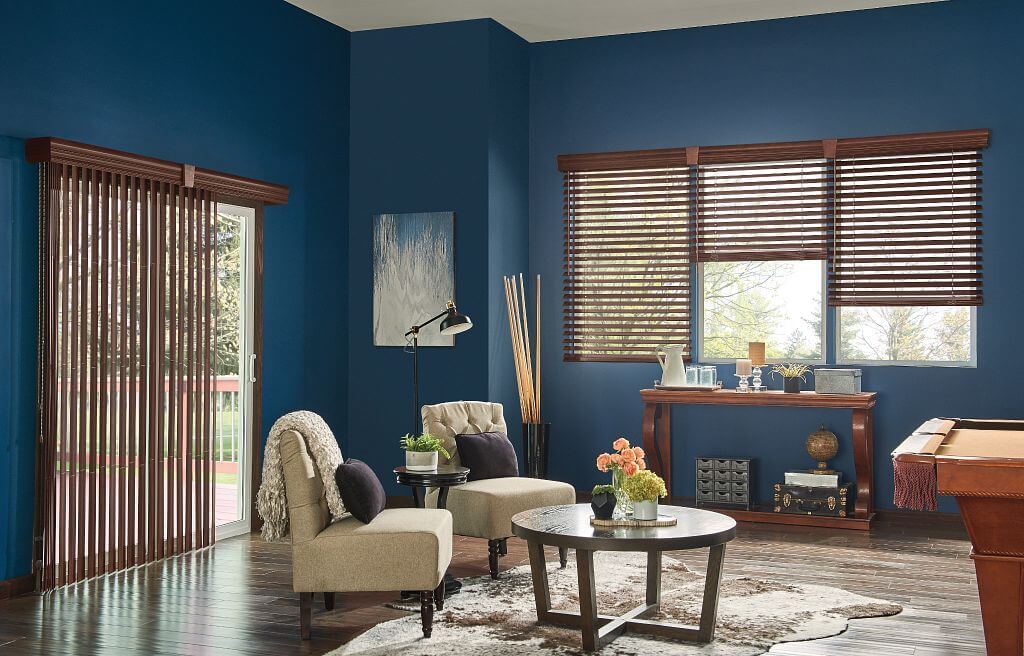
Wood blinds are crafted from real hardwood, often sourced from basswood or other sustainable species. Their natural grain, warmth, and color variations bring character to any space. Because they are made of genuine wood, each slat is unique, offering a luxurious finish that suits traditional and contemporary interiors alike.
Faux Wood Blinds: Synthetic Strength and Style
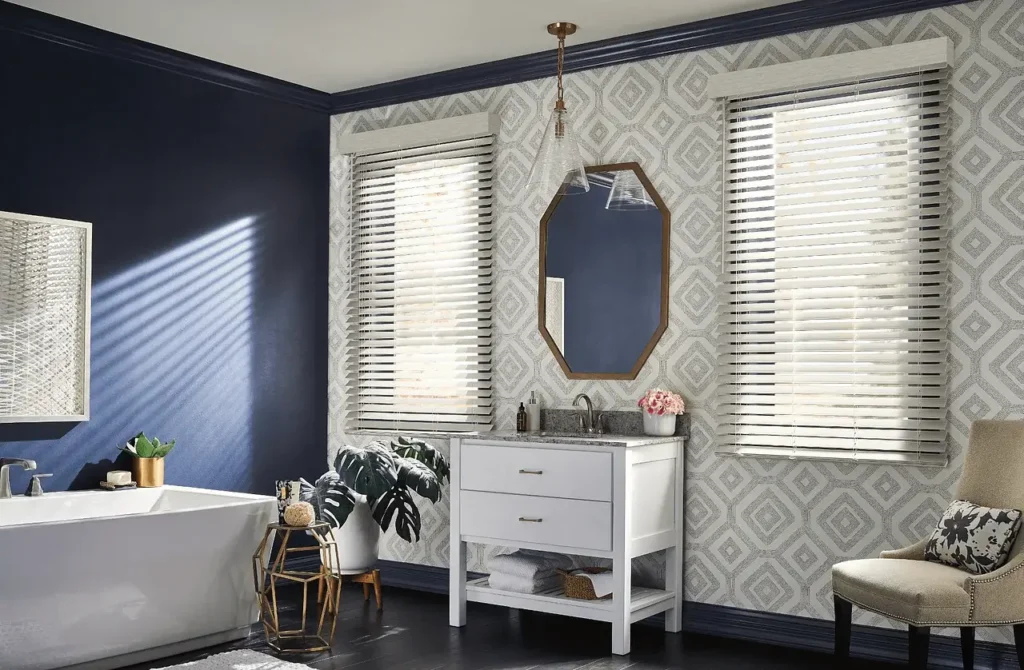
Faux wood blinds are made from composite materials, typically PVC, vinyl, or a blend of wood and synthetic fibers. Designed to mimic the look of real wood, they offer a durable and affordable alternative. Faux wood blinds are especially popular in high-moisture areas where natural wood may warp or fade over time.
Comparing Durability and Maintenance
Durability in Different Environments
Wood blinds are durable under normal interior conditions but can be sensitive to humidity and temperature changes. They perform best in living rooms, bedrooms, and offices.
Faux wood blinds, on the other hand, are built to withstand moisture, heat, and daily wear. This makes them an excellent choice for kitchens, bathrooms, or sunrooms.
Feature | Wood Blinds | Faux Wood Blinds |
Moisture Resistance | Moderate | High |
Warping/Fading | Possible in humid areas | Minimal risk |
Weight | Lightweight | Heavier |
Ideal Locations | Dry rooms | Moist or high-traffic areas |
Cleaning and Care
Wood blinds require a bit more attention to preserve their finish. Regular dusting and occasional polishing help maintain their luster, but they should not be soaked or exposed to harsh cleaners. Faux wood blinds are easier to maintain—simply wipe with a damp cloth and mild soap to keep them looking new.
Cost, Value, and Lifespan
Cost Comparison
When comparing wood blinds vs. faux wood blinds, price is one of the most significant factors.
- Wood blinds tend to be more expensive due to the quality of materials and craftsmanship involved.
- Faux wood blinds offer the same upscale look at a lower price point, making them a budget-friendly option for homeowners who want elegance without the premium cost.
Longevity and Investment
Wood blinds, when properly cared for, can last decades, especially if installed in stable indoor environments. Faux wood blinds also offer impressive longevity, with the added benefit of resistance to discoloration and damage in humid climates.
Aesthetic Appeal and Design Options
Customization and Style
Wood blinds stand out for their authentic texture, rich finishes, and customizable stains. Whether you prefer light oak, cherry, or espresso tones, they can be tailored to match your furniture and flooring.
Faux wood blinds also come in a wide range of colors and finishes, often indistinguishable from real wood at a glance. However, since they are manufactured, their textures and tones are more uniform.
Fit for Your Interior
For homeowners who prioritize a natural and sophisticated aesthetic, wood blinds remain a top choice. They bring depth and warmth to interiors, making them ideal for formal or cozy spaces. Faux wood blinds, with their durable construction and clean design, are great for modern and practical spaces where ease of maintenance is a priority.
Insulation, Privacy, and Performance
Thermal Efficiency
Both wood and faux wood blinds provide good insulation by blocking sunlight and reducing heat transfer. Wood’s natural properties help regulate indoor temperature, keeping rooms cooler in summer and warmer in winter. Faux wood blinds, being thicker and more resistant to humidity, maintain consistent performance in variable climates.
Light Control and Privacy
Both options offer excellent light control through adjustable slats. Wood blinds tend to diffuse light softly, creating a warm ambiance, while faux wood blinds provide more consistent coverage due to their denser material. Both ensure privacy without sacrificing style.
Pros and Cons Overview
Aspect | Wood Blinds | Faux Wood Blinds |
Material | Natural hardwood | Synthetic or composite |
Appearance | Authentic, warm, luxurious | Realistic, uniform, modern |
Durability | Excellent in dry spaces | Superior in humid environments |
Maintenance | Requires gentle care | Easy to clean |
Cost | Higher | More affordable |
Weight | Lighter | Heavier |
Customization | Wide range of stains | Many finishes available |
Longevity | Long-lasting with care | Long-lasting, low maintenance |
Choosing Between Wood and Faux Wood Blinds
Your final choice will depend on your environment, budget, and personal style. If you value authenticity, craftsmanship, and the natural warmth of wood, real wood blinds are worth the investment. However, if practicality, durability, and affordability top your list, faux wood blinds deliver exceptional value while maintaining a refined appearance.
At Made In The Shade Ashburn, our experts can help you compare materials, finishes, and installation options to find the perfect match for your home’s decor and lifestyle.
FAQs About Wood Blinds vs Faux Wood Blinds
1. Can wood blinds be used in bathrooms or kitchens?
While wood blinds can be used in these areas, it is not recommended due to moisture exposure, which can lead to warping or discoloration. Faux wood blinds are a better option for these spaces.
2. Do faux wood blinds look fake compared to real wood?
Not at all. Modern manufacturing techniques make faux wood blinds almost identical to real wood, with realistic textures and grain patterns that even professionals sometimes find hard to distinguish.
3. Are both types of blinds energy efficient?
Yes. Both wood and faux wood blinds improve insulation and help regulate indoor temperatures. Wood blinds offer natural thermal benefits, while faux wood blinds are designed for consistency in various climates.
Battle of the Slats
Choosing between wood blinds vs. faux wood blinds ultimately comes down to lifestyle and environment. Real wood adds timeless elegance and warmth, while faux wood offers resilience and practicality—both transforming your windows into stylish, functional features.
Bring comfort and sophistication to your space with custom wood or faux wood blinds. Schedule your free in-home consultation with Made In The Shade Ashburn today and let our experts guide you to the perfect fit for your home.

